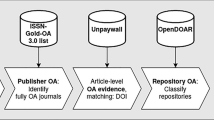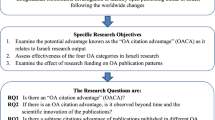Abstract
Open Access has emerged as an important movement worldwide during the last decade. There are several initiatives now that persuade researchers to publish in open access journals and to archive their pre- or post-print versions of papers in repositories. Institutions and funding agencies are also promoting ways to make research outputs available as open access. This paper looks at open access levels and patterns in research output from India by computationally analyzing research publication data obtained from Web of Science for India for the last 5 years (2014–2018). The corresponding data from other connected platforms—Unpaywall and Sci-Hub—are also obtained and analyzed. The results obtained show that about 24% of research output from India, during last 5 years, is available in legal forms of open access as compared to world average of about 30%. More articles are available in gold open access as compared to green and bronze. On the contrary, more than 90% of the research output from India is available for free download in Sci-Hub. We also found disciplinary differentiation in open access, but surprisingly these patterns are different for gold–green and black open access forms. Sci-Hub appears to be complementing the legal gold–green open access for less covered disciplines in them. The central institutional repositories in India are found to have low volume of research papers deposited.



Similar content being viewed by others
Notes
www.budapestopenaccessinitiative.org. Accessed on 25th June 2019.
Directory of open access (2018) Open access Repositories Operational Statues https://doaj.org.
https://arxiv.org/. Accessed on 25th June 2019.
https://en.wikipedia.org/wiki/Budapest_Open_Access_Initiative#cite_note-google.se-3. Accessed on 25th June 2019.
https://en.wikipedia.org/wiki/Bethesda_Statement_on_Open_Access_Publishing. Accessed on 25th June 2019.
https://openaccess.mpg.de/Berlin-Declaration. Accessed on 25th June 2019.
Indian Academy of Sciences https://www.ias.ac.in/. Accessed on 20th August 2019.
National Knowledge Commission. (2009). National Knowledge Commission. Report to the Nation 2006–2009. http://14.139.60.153/bitstream/123456789/112/1/National%20Knowledge%20Commission-Report%202006-2009%20.pdf. Accessed on 20th Aug. 2019.
http://www.csir.res.in. Accessed on 20th Aug. 2019.
DBT and DST Open Access Policy Policy on open access to DBT and DST funded research http://www.dst.gov.in/sites/default/files/APPROVED%20OPEN%20ACCESS%20POLICY-DBT%26DST%2812.12.2014%29_1.pdf. Accessed on 20-08-2019.
References
Archambault, E., Amyot, D., Deschamps, P., Nicol, A., Rebout, L., & Roberge, G. (2013). Proportion of open access peer-reviewed papers at the European and world levels-2004–2011. European Commission.
Archambault, É., Amyot, D., Deschamps, P., Nicol, A., Provencher, F., Rebout, L., et al. (2014). Proportion of open access papers published in peer-reviewed journals at the European and world levels—1996–2013. European Commission.
Arunachalam, S., & Muthu, M. (2011). Open access to scholarly literature in India—A status report (with emphasis on scientific literature). Bangalore: Centre for Internet and Society.
Bhardwaj, R. K. (2015). India’s contribution to open access movement. Journal of Knowledge & Communication Management.,5(2), 107–126.
Björk, B. C. (2012). The hybrid model for open access publication of scholarly articles: A failed experiment? Journal of the American Society for Information Science and Technology,63(8), 1496–1504.
Björk, B. C. (2016a). Hybrid open access—A longitudinal study. Journal of Informetrics,10(4), 919. https://doi.org/10.1016/j.joi.2016.08.002.
Björk, B.-C. (2016b). The open access movement at a crossroad: Are the big publishers and academic social media taking over? Learned Publishing,29(2), 131–134. https://doi.org/10.1002/leap.1021.
Björk, B. C. (2017). Gold, green, and black open access. Learned Publishing,30, 173–175. https://doi.org/10.1002/leap.1096.
Björk, B. C., Laakso, M., Welling, P., & Paetau, P. (2014). Anatomy of green open access. Journal of the Association for Information Science and Technology,65(2), 237–250.
Björk, B. C., Welling, P., Laakso, M., Majlender, P., Hedlund, T., & Guðnason, G. (2010). Open access to the scientific journal literature: Situation 2009. PLoS ONE,5(6), e11273. https://doi.org/10.1371/journal.pone.0011273.
Bohannon, J. (2016a). The frustrated science student behind Sci-Hub. Science, 352(6285), 511–511.
Bohannon, J. (2016b). Who’s downloading pirated papers? Everyone. Science, 352(6285), 508–512.
Bosman, J., & Kramer, B. (2018). Open access levels: A quantitative exploration using Web of Science and oaDOI data (No. e3520v1). PeerJ Preprints.
Cabanac, G. (2015). Bibliogifts in LibGen? A study of a text-sharing platform driven by biblioleaks and crowdsourcing. Journal of the Association for Information Science and Technology, 67(4), 874–884.
Das, A. K. (2008). Open access to knowledge and information: Scholarly literature and digital library initiatives-The South Asian Scenario. UNESCO Report.
Elbakyan, A. (2016a). Sci-Hub is a goal, changing the system is a method. Engineuring. Available from: https://engineuring.wordpress.com/2016/03/11/sci-hub-is-a-goal-changing-the-system-is-a-method/.
Elbakyan, A. (2016b). Why Sci-Hub is the true solution for open access: reply to criticism. Engineuring. Available from: http://engineuring.wordpress.com/2016/02/24/why-sci-hub-is-the-true-solution-for-open-access-reply-to-criticism/.
Elbakyan, A., & Bohannon, J. (2016). Sci-Hub download data. Dryad Digital Repository. https://doi.org/10.5061/dryad.q447c/1.
Faust, J. S. (2016). Sci-Hub: A solution to the problem of Paywalls, or merely a diagnosis of a broken system? Annals of Emergency Medicine,68(1), 15–17.
Ghosh, S. B., & Kumar Das, A. (2007). Open access and institutional repositories—A developing country perspective: A case study of India. IFLA Journal,33(3), 229–250.
Green, T. (2017). We’ve failed: Pirate black open access is trumping green and gold and we must change our approach. Learned Publishing,30, 325–329.
Greshake, B. (2017). Looking into Pandora’s Box: The content of Sci-Hub and its usage. F1000Research,6(541), 1–14.
Hajjem, C., Harnad, S., & Gingras, Y. (2005). Ten-year cross-disciplinary comparison of the growth of open access and how it increases research citation impact. Bulletin of the IEEE Computer Society Technical Committee on Data Engineering, 28(4), 39–47.
Himmelstein, D. S., Romero, A. R., McLaughlin, S. R., Greshake Tzovaras, B., & Greene, C. S. (2017). Sci-Hub provides access to nearly all scholarly literature. PeerJ Preprints, 5, e3100v1. https://doi.org/10.7287/peerj.preprints.3100v1.
Kumar, V., & Mahesh, G. (2017). Open access repositories in India: A lost opportunity. Current Science,112(2), 210–212.
Machin-Mastromatteo, J. D., Uribe-Torado, A., & Romero-Ortiz, M. E. (2016). Piracy of scientific papers in Latin America: An analysis of Sci-Hub usage data. Information Development,32(5), 1806–1814.
Madhan, M., Kimidi, S. S., Gunasekaran, S., & Arunachalam, S. (2017). Should Indian researchers pay to get their work published? Current Science,112(4), 703–713.
Mallapaty, S. (2019). Indian scientists launch preprint repository to boost research quality. Nature News. https://doi.org/10.1038/d41586-019-01082-0.
Martín-Martín, A., Costas, R., van Leeuwen, T., & López-Cózar, E. D. (2018). Evidence of open access of scientific publications in Google Scholar: A large-scale analysis. Journal of Informetrics,12(3), 819–841.
Mejia, C. R., Valladares-Garrido, M. J., Minan-Trapia, A., Serrano, F. T., Tobler-Gomez, L. E., Prerda-Castro, W., et al. (2017). Use, knowledge, and perception of the scientific contribution of Sci-Hub in medical students: Study in six contries in Latin America. PLoS ONE,12(10), e0185673.
Momin, S. S., & Gaonkar, R. C. (2016). Institutional repository-A gateway of global visibility: Case study. Research Dimensions,8(2), 103–110.
Nazim, M., & Devi, M. (2008). Open access journals and institutional repositories: Practical need and present trends in India. Annals of Library and Information Studies,55(1), 201–208.
Novo, L. A. B., & Onishi, V. C. (2017). Could Sci-Hub become a quicksand for authors. Information Development.,33(3), 324–325.
Panda, S. K. (2016). Shodhganga—A national level open access ETD repository of Indian electronic theses: Current status and discussions. Library Hi Tech News,33(1), 23–26.
Piryani, R., Dua, J., & Singh, V. K. (2019). Open access levels and patterns in scholarly articles from India. Current Science,117(9), 1435–1440.
Piwowar, H., Priem, J., Larivière, V., Alperin, J. P., Matthias, L., Norlander, B., et al. (2018). The state of OA: A large-scale analysis of the prevalence and impact of Open Access articles. PeerJ,6, e4375. https://doi.org/10.7287/peerj.preprints.3119v1.
Priego, E. (2016). Signal, not solution: Notes on why Sci-Hub is not opening access. The Winnower,3, e145624.
Ramachandran, R. (2000). Public access to Indian geographical data. Current Science,79(4), 450–467.
Roy, B. K., Biswas, S. C., & Mukhopadhyay, P. (2016). Open access repositories for Indian universities: Towards a multilingual framework. IASLIC Bulletin,61(4), 150–161.
Rupika, U. A., & Singh, V. K. (2016). Measuring the university–industry–government collaboration in Indian Research Output. Current Science,110(10), 1904.
Singh, P. (2016). Open access repositories in India: Characteristics and future potential. IFLA Journal,42(1), 16–24.
Strielkowski, W. (2017). Will the rise of Sci-Hub pave the road for the subscription-based access to publishing databases? Information Development,33(5), 540–542.
Travis, J. (2016). In survey, most give thumbs-up to pirated papers. Science News. https://doi.org/10.1126/science.aaf5704.
Tzovaras B.G. (2018). Sci-Hub download log of 2017. Zenodo. Retrieved https://doi.org/10.5281/zenodo.1158301.
Urs, S. R., & Raghavan, K. S. (2001). Vidyanidhi: Indian digital library of electronic theses. Communications of the ACM,44(5), 88–89.
Acknowledgements
The authors acknowledge the enabling support provided by the DST-NSTMIS funded project ‘Design of a Computational Framework for Discipline-wise and Thematic Mapping of Research Performance of Indian Higher Education Institutions (HEIs)’, bearing Grant No. DST/NSTMIS/05/04/2019-20, for this work.
Author information
Authors and Affiliations
Corresponding author
Rights and permissions
About this article
Cite this article
Singh, V.K., Piryani, R. & Srichandan, S.S. The case of significant variations in gold–green and black open access: evidence from Indian research output. Scientometrics 124, 515–531 (2020). https://doi.org/10.1007/s11192-020-03472-y
Received:
Published:
Issue Date:
DOI: https://doi.org/10.1007/s11192-020-03472-y




